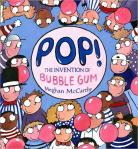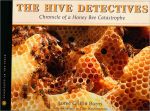Posts Tagged ‘gum’
Nonfiction with Kid Appeal
Posted on: October 3, 2010
This last summer was filled with teaching summer school classes and a dream vacation to Europe. One of the best parts was attending the IBBY conference in Santiago De Compostela, Spain. Since returning home, I have been reading some wonderful books. This post will focus on the excellent nonfiction and biographies I found. These titles will tantalize the reading taste buds of youngsters who like to read about things that are “real and have really happened.” So I am back to blogging this time about biography and nonfiction.
Dave the Potter Artist, Poet, Slave by Laban C. Hill. Illus. by Bryan Collier. (2010). Little, Brown and Company. Pages not numbered. All Ages. Biography.
This unusual and stunning biography touches the heart as the sparse, lyrical text and powerful illustrations team to unfold the story of a slave, whose pottery and the poems he inscribed on them made him an important American artist. The poetic text concentrates on Dave’s process of making the pottery. The book ends with, “But before the jar/completely hardened,/Dave picked up a stick/and wrote to let us know/that he was here./I wonder where/is all my relation/friendship to all–/and, every nation.” Collier uses collage and watercolors to show different perspectives of making the pots. Some are a series of close-ups of Dave’s hands molding the pots. Other images show the environment where Dave worked. At the end Hill provides more information about Dave, his poems and a photograph of five pots. Both the author’s and illustrator’s notes tell about the inspiration and research for the book. A bibliography and list of websites offer ways for students to learn more about Dave.
Pop! The Invention of Bubble Gum by Meghan McCarthy. (2010). Simon & Schuster. Pages not numbered. Grades 1-5. Biography.
This book has lots of kid appeal from the endpapers that feature colorful bubble gum balls on a bright pink background to the last pages with “Facts about Gum” and “More Facts About Gum.” McCarthy concentrates on how Walter Diemer, an accountant for a candy and gum factory, got stuck on inventing a new kind of gum, bubble gum. Walter “spent months playing with different mixtures” until the mixture “bubbled and popped.”’ Walter thought the mixture needed some color. ““Pink coloring was the only one I had at hand,”” so bubble gum became pink! Walter’s “Dubble Bubble” became a success and Walter was promoted to Vice-President of the company. The colorful comic illustrations add to the fun. The facts at the end will intrigue children, i.e. “If you chew gum nonstop for a year straight you will lose eleven pounds (good luck with that, though!).”
Bulu: African Wonder Dog by Dick Houston. (2010). Random House. 323 pages. Grades 5-9. Biography.
This is a great dog story but also an account of a remarkable couple, Anna and Steve Tolan. The Tolans, former police officers, left their comfortable life in England for new adventures in Zambia. There they created a refuge for orphaned animals and a wildlife education center for the children of the area. The Tolans acquired Bulu as a puppy and he is the star of their story. They were warned about having a pet in the African bush, and some of Bulu’s harrowing adventures show why that warning was accurate. He has encounters with a cobra, crocodile and lions. Bulu has heart and unusual courage and he survives. He fosters and nurtures many of the orphans – monkeys, warthogs, a baboon, a bushbuck, a baby elephant. Black and white photographs enrich the text and show Bulu with the other animals. There is humor and suspense in this book. It would make an excellent choice to read aloud.
How to Clean a Hippopotamus: A Look At Unusual Animal Partnerships by Steve Jenkins & Robin Page. (2010). Houghton Mifflin. Pages not numbered. Grades 1-4. Nonfiction.
Jenkins and Page provide young readers with fascinating facts about animal symbiosis. The text describes how the animals have formed relationships in which each animal helps the other. For example, the oxpecker bird “debugs” large African animals like the giraffe, rhino, deer and buffalo by searching “for ticks and insects, pulling them off with its beak.” The bird also warns its host when predators are approaching. The collage illustrations feature each host animal and its partner with appealing details. The book design makes it readable and attractive. The back matter provides more information about each featured animal and symbiosis. This is a book that children will pour over and return to again and again.
******************************************************************************
The next three books are outstanding new entries in the “Scientists in the Field” series. Together the books demonstrate how scientists around the world are working toward saving our environment and the creatures that dwell in it. Each book features stunning, full color, photographs that show close-ups of the creatures, the environments they live in and the scientists at work. The writing in each book gathers the reader into the narrative with stories from the field. These books are also outstanding in the way their text features, like sidebars, captions, insets, glossaries, indexes, further resources, guides to helping save the creatures, maps, bibliographies, appendixes are used to develop and extend the informative texts.
The Hive Detectives: Chronicle of a Honey Bee Catastrophe by Loree Griffin Burns. Photographs by Ellen Harasimowicz. (2010). Houghton Mifflin. 66 pages. Grades 5-8. Nonfiction.
The first sentence in this book makes the reader an active participant in the story. “Put on your veil, grab your hive tool, and light up your smoker… …we’re going into a beehive.” Burns first explains the vital role played by honey bees in pollinating crops, fruit and nut trees and vegetable plants. Then she describes colony collapse disorder (CCD), a mysterious scourge that is wiping out hives all over our country, and how scientists are working to understand how to combat it. The reader learns about bees and the ways bee keepers are taking care of them. Photographs of the bees in the hive and at their work are detailed and exciting to see. It is especially intriguing to learn about the scientists’ careful detective work in addressing the possible causes of CCD. An appendix provides more information about this amazing insect.
Kakapo Rescue: Saving the World’s Strangest Parrot by Sy Montgomery. Photographs by Nic Bishop. (2010). Houghton Mifflin. 74 pages. Grades 5-8. Nonfiction.
Montgomery and Bishop have other prize winning books in this series. This is sure to be another winner for them. This book tells about a project on a remote island off the New Zealand coast to save the last ninety-one kakapo parrots on earth. Compelling writing paints visual portraits of the unique parrots and the scientists’ efforts to save them.
It’s hours past midnight. You’d think any self-respecting parrot would be asleep. But not Lisa.
No, despite the late hour, this huge, soft, moss-green bird, looking somewhat like a parakeet who has eaten one side of the mushroom in Alice in Wonderland and grown into an eight-pound giant, decides this is a great time to waddle out of her nest—a nest that’s not in a tree, like a normal parrot’s, but underground.
A large size photograph of the bird accompanies these opening paragraphs. Montgomery and Bishop became part of the story because they spent ten-days on the island learning about the work of New Zealand’s National Kakapo Recovery Team. One of the last photographs shows Montgomery in “a dazzling encounter” with one of the parrots.
Project Seahorse by Pamela S. Turner. Photographs by Scott Tuason. (2010). Houghton Mifflin. 57 pages. Grades 5-8. Nonfiction.
This book also profiles an animal, the seahorse, which is in trouble because of environmental damage and overfishing. The underwater photographs of the appealing creatures dazzle. A variety of the species are pictured. This book focuses on the coral reefs off Handumon, a small village on an island in the Philippines. There the two women scientists who have founded Project Seahorse work tirelessly with local fishermen, villages and their research team to protect the seahorses and the livelihood of local fishing families. The photos of the scuba divers, fishermen at work and the gorgeous life of the coral reef compel the reader’s attention. Some chapters are just devoted to describing the unique aspects of the life cycle of the seahorse like the way the male seahorse gives birth from his brood pouch. Other chapters outline the threats to this gentle creature like traditional Chinese Medicine that uses dried, ground up seahorses for medicine. A final chapter describes the positive outcomes that have come about through the efforts of Project Seahorse.






